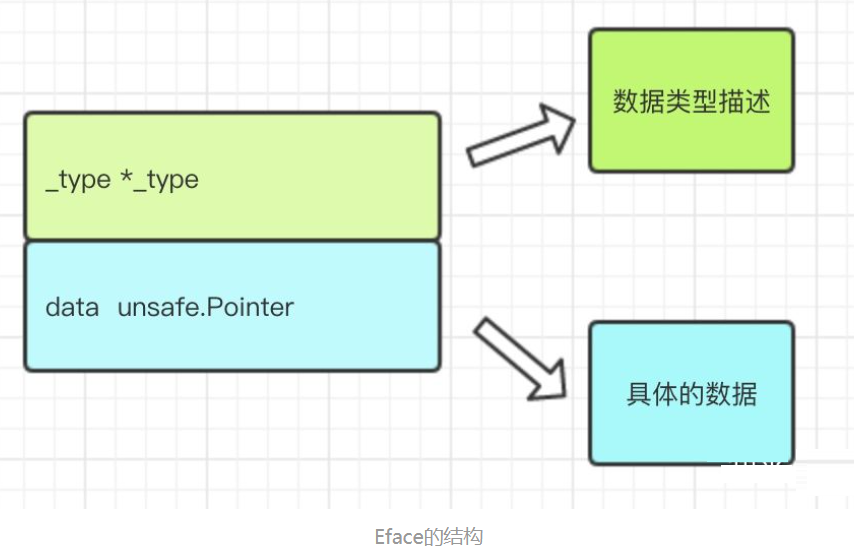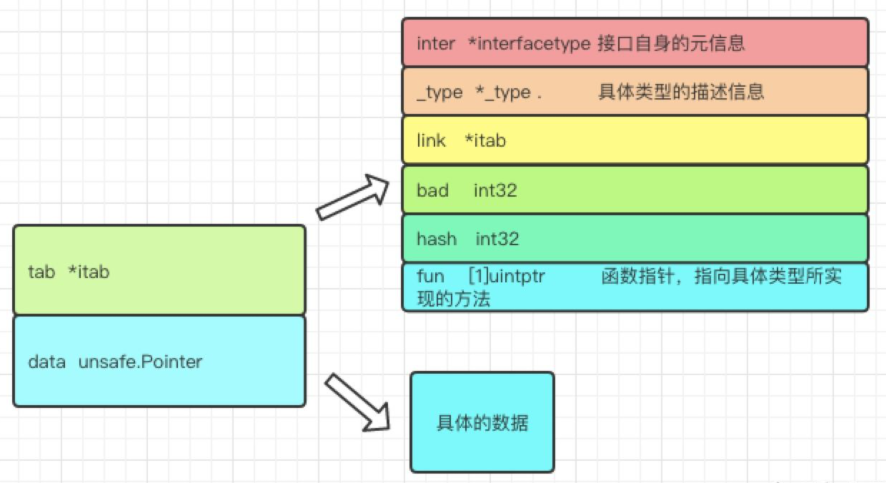interface
1.interface
01.interface
1.1 interface作用
接口是 Go 语言的重要组成部分,它在 Go 语言中通过一组方法指定了一个对象的行为
接口 interface 的引入能够让我们在 Go 语言更好地组织并写出易于测试的代码
golang中的接口分为
带方法的接口和空接口- iface:表示带方法的接口
- eface:表示空接口
1.2 eface空接口
- 空接口eface结构比较简单,由两个属性构成
- 一个是
类型信息_type,一个是数据信息 - 其数据结构声明如下:
type eface struct {
_type *_type
data unsafe.Pointer
}
- 其中_type是GO语言中所有类型的公共描述,Go语言几乎所有的数据结构都可以抽象成 _type,是所有类型的公共描述
- type负责决定data应该如何解释和操作
- type的结构代码如下:
type _type struct {
size uintptr
ptrdata uintptr // size of memory prefix holding all pointers
hash uint32 // 类型哈希
tflag tflag
align uint8 // _type作为整体变量存放时的对齐字节数
fieldalign uint8
kind uint8
alg *typeAlg
// gcdata stores the GC type data for the garbage collector.
// If the KindGCProg bit is set in kind, gcdata is a GC program.
// Otherwise it is a ptrmask bitmap. See mbitmap.go for details.
gcdata *byte
str nameOff
ptrToThis typeOff // type for pointer to this type, may be zero
}- data表示指向具体的实例数据,由于Go的参数传递规则为值传递
- 如果希望可以通过interface对实例数据修改,则需要传入指针
- 此时data指向的是指针的副本,但指针指向的实例地址不变,仍然可以对实例数据产生修改。
1.3 iface带方法的接口
- iface 表示带方法的数据结构,非空接口初始化的过程就是初始化一个iface类型的结构
- 其中data的作用同eface的相同,这里不再多加描述。
type iface struct {
tab *itab
data unsafe.Pointer
}
- iface结构中最重要的是itab结构(结构如下),每一个
itab都占 32 字节的空间 - itab可以理解为pair<interface type, concrete type>
- itab里面包含了interface的一些关键信息,比如method的具体实现
type itab struct {
inter *interfacetype // 接口自身的元信息
_type *_type // 具体类型的元信息
link *itab
bad int32
hash int32 // _type里也有一个同样的hash,此处多放一个是为了方便运行接口断言
fun [1]uintptr // 函数指针,指向具体类型所实现的方法
}
// interface type包含了一些关于interface本身的信息,比如package path,包含的method
type interfacetype struct {
typ _type
pkgpath name
mhdr []imethod
}
type imethod struct { //这里的 method 只是一种函数声明的抽象,比如 func Print() error
name nameOff
ityp typeOff
}1.4 interface设计的优缺点
- 优点,非侵入式设计,写起来更自由,无需显式实现,只要实现了与 interface 所包含的所有函数签名相同的方法即可。
- 缺点,duck-typing风格并不关注接口的规则和含义,也没法检查,不确定某个struct具体实现了哪些interface。
- 只能通过goru工具查看。
interface
http://coderedeng.github.io/2021/02/05/Go进阶 - interface/